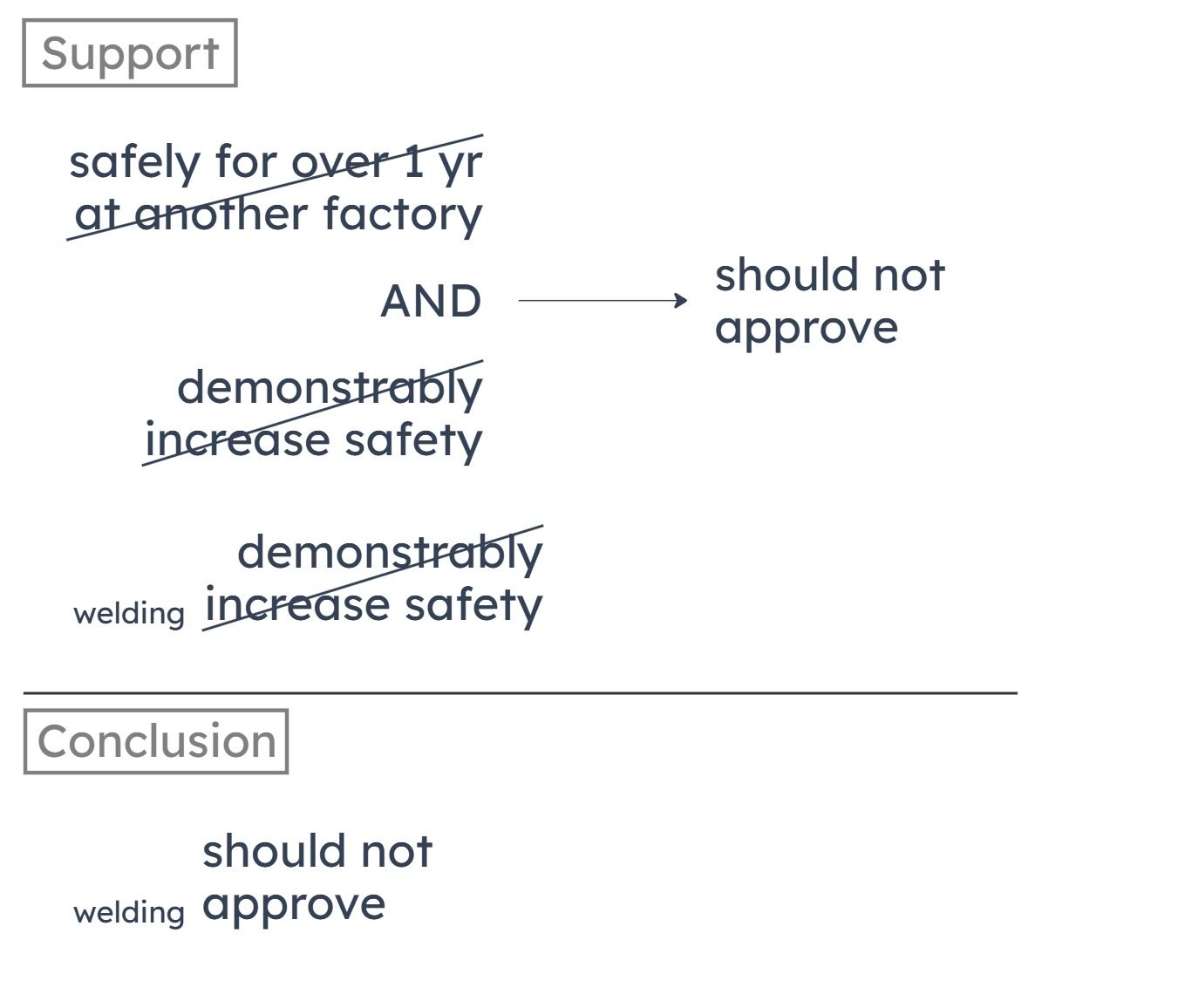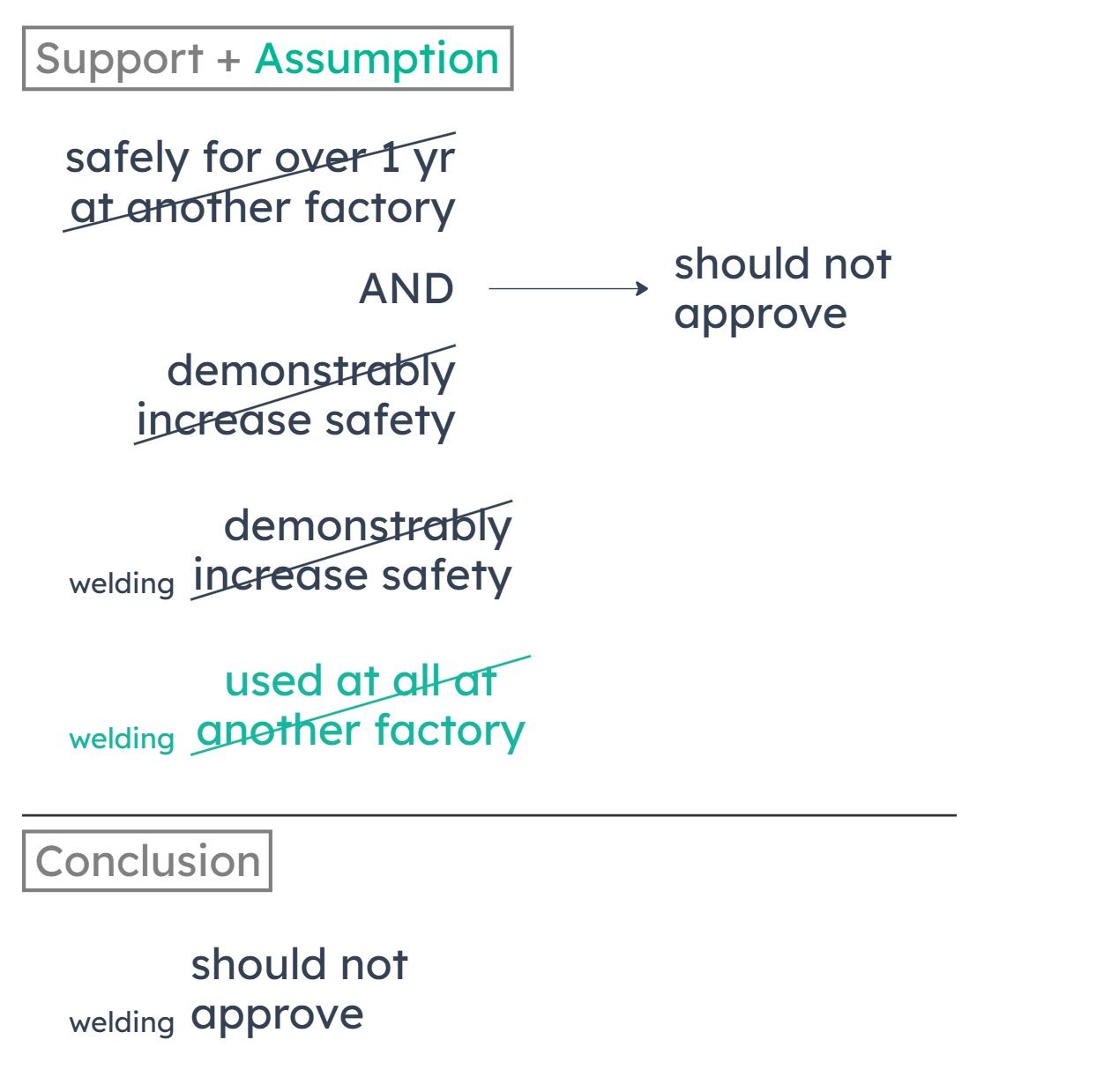A
The administrator is cognizant of the extra costs involved in granting employee benefits to teaching assistants.
B
The university employs adjunct instructors who receive compensation similar to that of its teaching assistants.
C
The university has proposed that in the interest of economy, 10 percent of the faculty be replaced with teaching assistants.
D
Most teaching assistants earn stipends that exceed their cost of tuition.
E
Teaching assistants work as much and as hard as do other university employees.
Application: The safety inspector should not approve the proposed new welding process, for it cannot be shown to increase safety at the factory.
In order for it to be appropriate to approve a new manufacturing process, it must (1) have been used safely for more than a year at another factory, OR (2) demonstrably increase safety at the factory at which the process will be implemented.
The new welding process can’t be shown to increase safety at the factory.

A
The factory at which the new welding process was first introduced has had several problems associated with the process.
B
The proposed new welding process has not been used in any other factory.

C
Some of the manufacturing processes currently in use at the factory are not demonstrably safer than the new welding process.
D
The safety inspector will not approve any new process that has not been used extensively elsewhere.
E
The proposed new welding process has been used in only one other factory.
A
the claims made in support of this conclusion are inaccurate
B
Sauk’s work has aesthetic merit
C
these critics are motivated by antipathy toward Sauk’s political ideas
D
the claims made in support of this conclusion have not been shown to be correct
E
the claims made in support of this conclusion have not been shown to be relevant to it
A
takes lack of evidence for a view as grounds for concluding that the view is false
B
presupposes as evidence the conclusion that it is trying to establish
C
places undue reliance on the judgments of an authority figure
D
confuses legal standards for guilt with moral standards for guilt
E
concludes that a judgment is suspicious merely on the grounds that it was reached quickly
A
Clemens has long been portrayed as an honest politician by the local news media.
B
The local news media were wrong to herald Clemens as an honest politician.
C
The local news media show too much deference toward public figures.
D
Reporters from the local newspaper neglected to follow leads that might have exposed the scandal much earlier.
E
The local newspaper’s treatment of Clemens is indicative of its treatment of public figures in general.
A
takes for granted that the boss’s assessments of employee presentations are generally not accurate
B
fails to distinguish between more of something and too much of it
C
fails to consider that an audience’s attention might wander for reasons other than being presented with too much detail
D
infers a generalization based only on a single case
E
confuses two distinct meanings of the key term “detail”
A
Tobacco hornworms that first fed on nightshade leaves show no preference for any one variety of nightshade plant over any other.
B
If taste receptors are removed from tobacco hornworms that first fed on nightshade leaves, those hornworms will subsequently feed on other leaves.
C
Tobacco hornworm eggs are most commonly laid on nightshade plants.
D
Indioside D is not the only chemical that occurs only in nightshade plants.
E
The taste receptors of the tobacco hornworm have physiological reactions to several naturally occurring chemicals.
Home ownership is a sign of economic prosperity. This makes it somewhat surprising that across the various regions of Europe and North America, high levels of home ownership correspond with high levels of unemployment.
"Surprising" Phenomenon
Why is it that, even though home ownership is a sign of economic prosperity, high levels of home ownership correspond with high levels of unemployment across Europe and North America?
Objective
The correct answer will connect home ownership and unemployment in a way that explains why home ownership can lead to or cause unemployment, either by causing a homeowner to lose his job or by making that homeowner less able to acquire a new job.
A
Home ownership makes it more difficult to move to a place where jobs are more plentiful.
This explains the connection between home ownership and unemployment. If someone buys a home in a place with few available jobs, it is more difficult for him to move to a place with more available jobs and thus, it is more difficult for him to acquire a job.
B
Over the last few decades jobs have been moving from centralized areas to locations that are closer to homeowners.
This deepens the conflict by saying that jobs are more available to or convenient for homeowners. It does not provide an explanation for why home ownership and unemployment are connected.
C
The correspondence between high levels of home ownership and high levels of unemployment holds across countries with widely different social systems.
It may be the case that home ownership and unemployment are connected even across countries in Europe and North America with different social systems. But this does not provide an explanation for why home ownership and unemployment are connected in the first place.
D
People who own homes are more likely than those who rent to form support networks that help them to learn of local jobs.
Like (B), this deepens the conflict by saying that jobs are more available to or convenient for homeowners. It does not provide an explanation for why home ownership and unemployment are connected.
E
People are more likely to buy homes when they are feeling economically secure.
This provides a connection between home ownership and economic security, rather than between home ownership and unemployment. We cannot assume that unemployment gives one a feeling of economic security, so (E) does nothing to resolve the apparent conflict.
The size of the spleen is a good indicator of how healthy a bird is: sickly birds generally have significantly smaller spleens than healthy birds. Researchers found that, in general, birds that had been killed by predators had substantially smaller spleens than birds killed accidentally.
Summary
The size of a bird’s spleen is a good indicator of the bird’s health. Sick birds usually have much smaller spleens than healthy birds. Researchers found that birds killed by predators generally had much smaller spleens than those killed accidentally.
Strongly Supported Conclusions
Healthier birds are less likely to be killed by predators and sickly birds are more likely to be killed by predators.
Predators may target weaker birds over healthier birds.
Accidental deaths in birds may be less related to healthiness than death by predation.
A
Predators are unable to kill healthy birds.
Unsupported. We know that birds killed by predators generally have smaller spleens, but we cannot conclude that predators are unable to kill healthy birds.
B
Most birds with smaller than average spleens are killed by predators.
Unsupported. Birds killed by predators generally have smaller spleens, but we cannot conclude that most birds with small spleens are killed by predators. Perhaps most birds die from some other cause but, of the few birds killed by predators, many have small spleens.
C
Predators can sense whether a bird is sick.
Unsupported. Predators tend to kill birds with smaller spleens, but this does not mean that predators can sense whether a bird is sick. Perhaps sick birds are simply slower than healthy ones and cannot escape predators. The stimulus doesn’t give us enough information on this.
D
Sickly birds are more likely than healthy birds to be killed by predators.
Strongly supported. Sickly birds usually have smaller spleens than healthy birds. And birds with smaller spleens are more likely to be killed by predators. So, sickly birds are more likely than healthy birds to be killed by predators.
E
Small spleen size is one of the main causes of sickness in birds.
Unsupported. Sick birds tend to have small spleens, but we cannot conclude that small spleens cause sickness in birds.